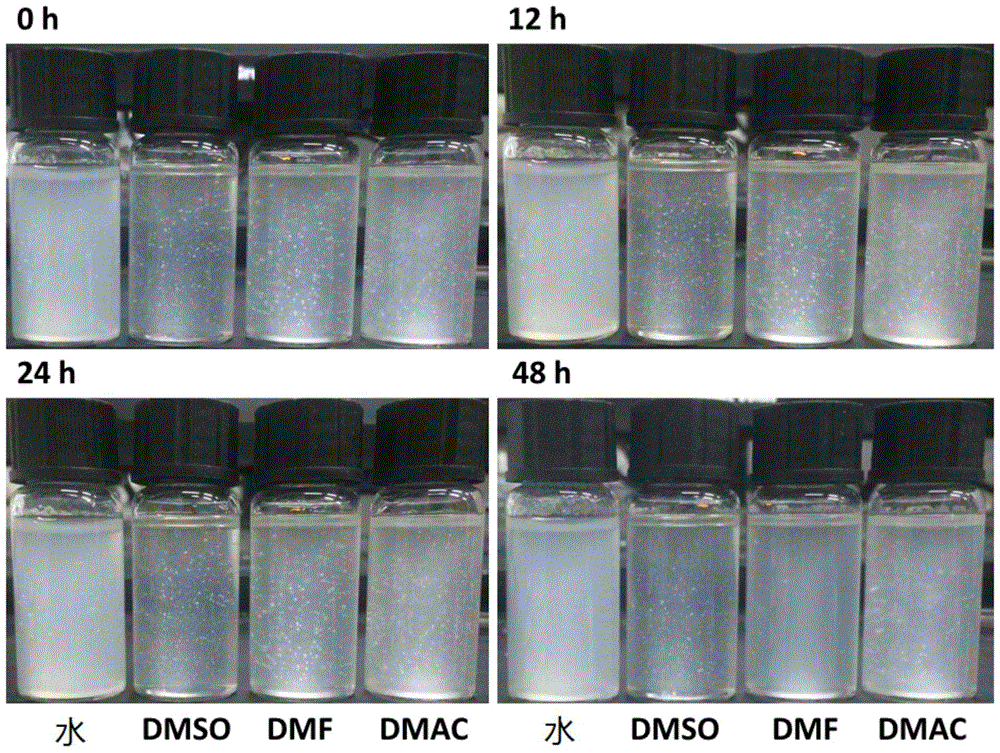Method combining formic acid preprocessing and high-pressure homogenization to prepare nano-crystalline cellulose fibrils
A technology of nanocellulose and cellulose, applied in the field of natural polymer material preparation, can solve the problems of far less enhancement effect, complicated reaction system, small length and diameter of CNCs, etc., to increase interface compatibility, easy control of reaction, Excellent effect
- Summary
- Abstract
- Description
- Claims
- Application Information
AI Technical Summary
Problems solved by technology
Method used
Image
Examples
preparation example Construction
[0038] In step 1) of the method for preparing CNFs according to the present invention: the weight ratio of the added cellulose raw material to the added formic acid solution is 1:10-100, when the weight ratio is less than 1:10, that is, the amount of formic acid solution added is insufficient , the reaction is not complete enough; and when the weight ratio is greater than 1:100, that is, the amount of formic acid solution is excessive, it is not economical enough.
[0039] In the prior art, in order to realize the defibrillation of cellulose in formic acid solution, catalysts, such as metal salt catalysts, inorganic acids, etc. must be used. Although the use of catalyst can shorten the time of defibrillation, it will inevitably remain in the final product, which will adversely affect the performance of the product. In order to overcome the problem of catalyst residue, the reaction product must be post-treated such as filtration step, the catalyst has been removed. However, th...
Embodiment 1
[0045] Weigh 3 g of absolute dry bleached spruce wood pulp into a 250 mL round bottom flask, add 100 mL of 88% (w / w) formic acid solution, and stir magnetically at 95° C. for 6 h. After the reaction, the flask was quickly placed in a cold water bath to cool to room temperature, and then the reaction mixture was transferred into a centrifuge tube and centrifuged at 5000 rpm for 5 min. The hydrolyzate can be directly returned to pretreat the next batch of cellulosic raw material. The precipitated jelly was washed by centrifugation with distilled water until neutral, and the centrifuged product was diluted with distilled water to a concentration of 0.2 wt%, and then homogenized 10 times by a high-pressure homogenizer at 60 MPa to obtain a viscous CNFs product. The yield of CNFs prepared in this example was 88% (relative to the original dry bleached spruce wood pulp). The FTIR pictures before and after hydrolysis are shown in the attachment figure 2 , as attached figure 2 Sho...
Embodiment 2
[0047] Weigh 3 g of absolute dry bleached eucalyptus pulp into a 250 mL round bottom flask, add 60 mL of 85% (w / w) formic acid solution, and magnetically stir at 90° C. for 5 h. After the reaction, the flask was quickly placed in a cold water bath to cool to room temperature, and then the reaction mixture was moved into a centrifuge tube and centrifuged at 5000 rpm for 10 min. The hydrolyzate can be directly returned to pretreat the next batch of cellulosic raw material. The precipitated jelly was centrifuged and washed with distilled water until neutral, and the centrifuged product was diluted with distilled water to a concentration of 0.5 wt%, and then homogenized 8 times by a high-pressure homogenizer at 80 MPa to obtain a viscous CNFs product. The yield of CNFs obtained in this example is 85% (relative to the original absolute dry bleached eucalyptus pulp), and the crystallinity is increased to 72% of CNFs from 65% of the original slurry (Pulp). The XRD patterns before and...
PUM
| Property | Measurement | Unit |
|---|---|---|
| boiling point | aaaaa | aaaaa |
Abstract
Description
Claims
Application Information
 Login to View More
Login to View More - R&D
- Intellectual Property
- Life Sciences
- Materials
- Tech Scout
- Unparalleled Data Quality
- Higher Quality Content
- 60% Fewer Hallucinations
Browse by: Latest US Patents, China's latest patents, Technical Efficacy Thesaurus, Application Domain, Technology Topic, Popular Technical Reports.
© 2025 PatSnap. All rights reserved.Legal|Privacy policy|Modern Slavery Act Transparency Statement|Sitemap|About US| Contact US: help@patsnap.com



